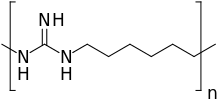Polyhexamethylene guanidine
Polyhexamethylene guanidine (PHMG) is a guanidine derivative that is used as a biocidal disinfectant, often in the form of its salt polyhexamethylene guanidine phosphate (PHMG-P).
 | |
| Names | |
|---|---|
| IUPAC name
Poly(iminocarbonimidoylimino-1,6-hexanediyl) | |
Other names
| |
| Identifiers | |
| |
| Abbreviations | PHMG, PHMG-P |
| ChemSpider |
|
| Properties | |
| (C7H15N3)n | |
| 280 g/L[1] | |
Except where otherwise noted, data are given for materials in their standard state (at 25 °C [77 °F], 100 kPa). | |
| Infobox references | |
Studies have shown that PHMG in solution has fungicidal as well as bactericidal activity against both Gram-positive and Gram-negative bacteria.[2] The substance also has detergent, anti-corrosive, and flocculant properties and prevents biofouling.[3] PHMG-P is a white powdered solid,[1] and as all polyguanidine salts, readily soluble in water.[3]
Toxicity
Unlike the related polymer polyhexanide (PHMB), PHMG has been described as a relatively new compound with properties, potency, and effects being not yet fully recognized. Preliminary findings indicate that PHMG and its derivatives primarily rely on damaging the cell membrane by inhibiting the activity of cellular dehydrogenases.[2]
When PHMG is aerosolized and inhaled, it harms the lungs, causing death of the cells lining the bronchioles and widespread damage to alveoli, along with bronchiolitis obliterans,[4][5] an often fatal form of non-reversible obstructive lung disease in which the bronchiole are compressed and narrowed by fibrosis (scar tissue) and/or inflammation.[6]
Uses
PHMG was used in Russia to disinfect hospitals[5] and from 2001 on, it was widely used in South Korea as a disinfectant to prevent microbial contamination in household humidifiers.[7] PHMG was "originally marketed for cleaning a humidifier's water tank but instead used by the public as a water additive to suppress microbial growth."[4]
South Korean lung disease outbreak and deaths
The pulmonary toxicity of PHMG was discovered due to an outbreak of severe lung disease in South Korea, detected in children in the spring of the years 2006 to 2011, and in adults in the spring of 2011; the mortality rate in children was 58%, while among adults, 53% died or required lung transplantation.[4] Autopsies and epidemiological work, followed up by animal studies, led the South Korean CDC to identify PHMG used in humidifiers as the cause.[4][5] It was banned in 2011, and new cases ceased occurring.[4][5]
Reckitt Benckiser was one of the companies that sold this product in South Korea and it resisted taking responsibility until May 2016, when the Korean division chief apologized to victims and families in a press conference and offered compensation to the families of those who died to those who were injured; it was the first time the company had acknowledged that its products containing PHMG were harmful.
References
- "Material Safety Data Sheet" (PDF). SK Chemicals. 2 December 2002. Archived from the original (PDF) on 9 June 2016. Retrieved 3 May 2016.
- Maciej Walczak; Agnieszka Richert; Aleksandra Burkowska-But (2014). "The effect of polyhexamethylene guanidine hydrochloride (PHMG) derivatives introduced into polylactide (PLA) on the activity of bacterial enzymes". Journal of Industrial Microbiology & Biotechnology. 41 (11): 1719–1724. doi:10.1007/s10295-014-1505-5. PMC 4201754. PMID 25189811.
- Alexander Chirkunov; Yurii Kuznetsov (2015). "Corrosion inhibitors in Cooling Water systems". In Zahid Amjad; Konstantinos D. Demadis (eds.). Mineral Scales and Deposits: Scientific and Technological Approaches. Elsevier. pp. 85 ff., here: 99 f. ISBN 978-0-444-63228-9.
- Cummings, K. J.; Kreiss, K. (2015). "Occupational and environmental bronchiolar disorders". Seminars in Respiratory and Critical Care Medicine. 36 (3): 366–78. doi:10.1055/s-0035-1549452. PMC 4610354. PMID 26024345.
- Dirk W. Lachenmeier (2015). "Chapter 24 – Antiseptic Drugs and Disinfectants". Side Effects of Drugs Annual. 37. pp. 273–279. doi:10.1016/bs.seda.2015.06.005. ISBN 9780444635259.
- Merriam-Webster Medical Dictionary > bronchiolitis obliterans Retrieved on August, 2010
- Lee Hyun-jeong for the Korea Herald. April 24, 2016 Oxy suspected of watering down report